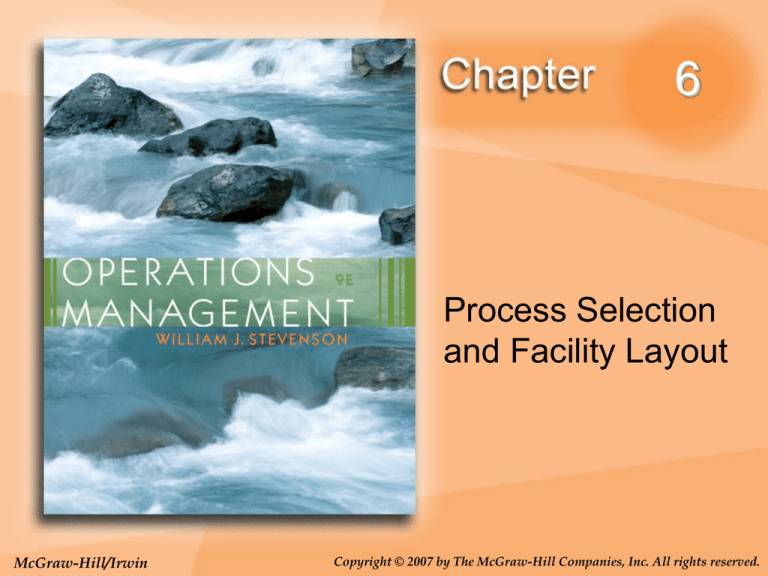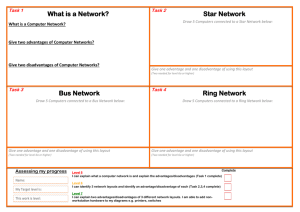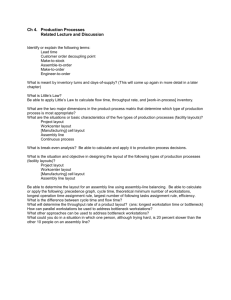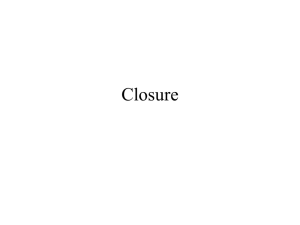
6
Process Selection
and Facility Layout
McGraw-Hill/Irwin
Copyright © 2007 by The McGraw-Hill Companies, Inc. All rights reserved.
Learning Objectives
Explain the strategic importance of process
selection.
Explain the influence that process selection
has on an organization.
Describe the basic processing types.
Discuss automated approaches to
processing.
Explain the need for management of
technology.
6-2
Learning Objectives
List some reasons for redesign of layouts.
Describe the basic layout types.
List the main advantages and
disadvantages of product layouts and
process layouts.
Solve simple line-balancing problems.
Develop simple process layouts.
6-3
Introduction
Process selection
Deciding on the way production of goods or
services will be organized
Major implications
Capacity planning
Layout of facilities
Equipment
Design of work systems
6-4
Figure 6.1
Process Selection and
System Design
Forecasting
Capacity
Planning
Product and
Service Design
Technological
Change
Facilities and
Equipment
Layout
Process
Selection
Work
Design
6-5
Process Strategy
• Key aspects of process strategy
–
Capital intensive – equipment/labor
–
Process flexibility
–
Technology
–
Adjust to changes
–
Design
–
Volume
–
technology
6-6
Technology
Technology: The application of scientific
discoveries to the development and
improvement of products and services and
operations processes.
Technology innovation: The discovery and
development of new or improved products,
services, or processes for producing or
providing them.
6-7
Kinds of Technology
Operations management is primarily
concerned with three kinds of technology:
Product and service technology
Process technology
Information technology
All three have a major impact on:
Costs
Productivity
Competitiveness
6-8
Technology Competitive
Advantage
Innovations in
Products and services
Cell phones
PDAs
Wireless computing
Processing technology
Increasing productivity
Increasing quality
Lowering costs
6-9
Technology Acquisition
Technology can have benefits but …
Technology risks include:
What technology will and will not do
Technical issues
Economic issues
Initial costs, space, cash flow, maintenance
Consultants and/or skilled employees
Integration cost, time resources
Training, safety, job loss
6-10
Process Selection
Variety
Batch
How much
Flexibility
What degree
Job Shop
Repetitive
Volume
Expected output
Continuous
6-11
Process Types
Job shop
Small scale
Batch
Moderate volume
Repetitive/assembly line
High volumes of standardized goods or
services
Continuous
Very high volumes of non-discrete goods
6-12
Figure 6.2
Product and Service
Processes
Process Type
Job Shop
Appliance repair
Emergency
room
Ineffective
Commercial
baking
Batch
Classroom
Lecture
Automotive
assembly
Repetitive
Automatic
carwash
Continuous
(flow)
Ineffective
Steel Production
Water purification
6-13
Product – Process Matrix
Figure 6.2 (cont’d)
Dimension
Job variety
Very High
Moderate
Low
Very low
Process
flexibility
Very High
Moderate
Low
Very low
Unit cost
Very High
Moderate
Low
Very low
Volume of
output
Very High
Low
High
Very low
6-14
Product and Process Profiling
Process selection can involve substantial
investment in
Equipment
Layout of facilities
Product profiling: Linking key product or service
requirements to process capabilities
Key dimensions
Range of products or services
Expected order sizes
Pricing strategies
Expected schedule changes
Order winning requirements
6-15
Automation
Automation: Machinery that has sensing
and control devices that enables it to
operate
Fixed automation
Programmable automation
6-16
Automation
• Computer-aided design and
manufacturing systems (CAD/CAM)
• Numerically controlled (NC) machines
• Robot
• Manufacturing cell
• Flexible manufacturing systems(FMS)
• Computer-integrated manufacturing (CIM)
6-17
Facilities Layout
Layout: the configuration of
departments, work centers, and
equipment, with particular emphasis on
movement of work (customers or
materials) through the system
Product layouts
Process layouts
Fixed-Position layout
Combination layouts
6-18
Objective of Layout Design
1. Facilitate attainment of product or service
quality
2. Use workers and space efficiently
3. Avoid bottlenecks
4. Minimize unnecessary material handling
costs
5. Eliminate unnecessary movement of
workers or materials
6. Minimize production time or customer
service time
7. Design for safety
6-19
Importance of Layout
Decisions
Requires substantial investments of
money and effort
Involves long-term commitments
Has significant impact on cost and
efficiency of short-term operations
6-20
The Need for Layout Decisions
Inefficient operations
For Example:
High Cost
Bottlenecks
Changes in the design
of products or services
Accidents
The introduction of new
products or services
Safety hazards
6-21
The Need for Layout Design
(Cont’d)
Changes in
environmental
or other legal
requirements
Changes in volume of
output or mix of
products
Morale problems
Changes in methods
and equipment
6-22
Basic Layout Types
Product layouts
Process layouts
Fixed-Position layout
Combination layouts
6-23
Basic Layout Types
Product layout
Layout that uses standardized processing
operations to achieve smooth, rapid, highvolume flow
Process layout
Layout that can handle varied processing
requirements
Fixed Position layout
Layout in which the product or project
remains stationary, and workers, materials,
and equipment are moved as needed
6-24
Product Layout
Figure 6.4
Raw
materials
or customer
Material
and/or
labor
Station
1
Material
and/or
labor
Station
2
Material
and/or
labor
Station
3
Station
4
Finished
item
Material
and/or
labor
Used for Repetitive or Continuous Processing
6-25
Advantages of Product Layout
High rate of output
Low unit cost
Labor specialization
Low material handling cost
High utilization of labor and equipment
Established routing and scheduling
Routing accounting and purchasing
6-26
Disadvantages of Product Layout
Creates dull, repetitive jobs
Poorly skilled workers may not maintain
equipment or quality of output
Fairly inflexible to changes in volume
Highly susceptible to shutdowns
Needs preventive maintenance
Individual incentive plans are
impractical
6-27
A U-Shaped Production Line
Figure 6.6
In
1
2
3
4
5
Workers
6
Out
10
9
8
7
6-28
Process Layout
Figure 6.7
Process Layout
(functional)
Dept. A
Dept. C
Dept. E
Dept. B
Dept. D
Dept. F
Used for Intermittent processing
Job Shop or Batch Processes
6-29
Product Layout
Figure 6.7 (cont’d)
Product Layout
(sequential)
Work
Station 1
Work
Station 2
Work
Station 3
Used for Repetitive Processing
Repetitive or Continuous Processes
6-30
Advantages of Process Layouts
Can handle a variety of processing
requirements
Not particularly vulnerable to equipment
failures
Equipment used is less costly
Possible to use individual incentive
plans
6-31
Disadvantages of Process
Layouts
In-process inventory costs can be high
Challenging routing and scheduling
Equipment utilization rates are low
Material handling slow and inefficient
Complexities often reduce span of
supervision
Special attention for each product or
customer
Accounting and purchasing are more
6-32
Fixed Position Layouts
Fixed Position Layout: Layout in which the
product or project remains stationary, and
workers, materials, and equipment are
moved as needed.
Nature of the product dictates this type of
layout
Weight
Size
Bulk
Large construction projects
6-33
Cellular Layouts
Cellular Production
Layout in which machines are grouped into
a cell that can process items that have
similar processing requirements
Group Technology
The grouping into part families of items with
similar design or manufacturing
characteristics
6-34
Functional vs. Cellular Layouts
Table 6.3
Dimension
Functional
Cellular
Number of moves
between departments
many
few
Travel distances
longer
shorter
Travel paths
variable
fixed
Job waiting times
greater
shorter
Throughput time
higher
lower
Amount of work in
process
higher
lower
Supervision difficulty
higher
lower
Scheduling complexity
higher
lower
Equipment utilization
lower
higher
6-35
Service Layouts
Warehouse and storage layouts
Retail layouts
Office layouts
Service layouts must be aesthetically
pleasing as well as functional
6-36
Design Product Layouts: Line
Balancing
Line Balancing is the process of assigning
tasks to workstations in such a way that
the workstations have approximately
equal time requirements.
6-37
Cycle Time
Cycle time is the maximum time
allowed at each workstation to
complete its set of tasks on a unit.
6-38
Determine Maximum Output
OT
Output rate =
CT
OT operating time per day
D = Desired output rate
OT
CT = cycle time =
D
6-39
Determine the Minimum Number
of Workstations Required
N=
( t)
CT
t = sum of task time
6-40
Precedence Diagram
Figure 6.11
Precedence diagram: Tool used in line balancing to
display elemental tasks and sequence requirements
0.1 min.
1.0 min.
a
b
c
0.7 min.
d
0.5 min.
A Simple Precedence
Diagram
e
0.2 min.
6-41
Example 1: Assembly Line
Balancing
Arrange tasks shown in Figure 6.10
into three workstations.
Use a cycle time of 1.0 minute
Assign tasks in order of the most number
of followers
6-42
Example 1 Solution
Eligible
Revised
Assign Time
Task
Remaining
1.0
0.9
0.2
a, c
c
none
a
c
-
0.9
0.2
2
1.0
b
b
0.0
3
1.0
0.5
0.3
d
e
-
d
e
-
0.5
0.3
Time
Workstation Remaining
1
Station
Idle Time
0.2
0.0
0.3
0.5
6-43
Calculate Percent Idle Time
Idle time per cycle
Percent idle time =
(N)(CT)
Efficiency = 1 – Percent idle time
6-44
Line Balancing Rules
Some Heuristic (intuitive) Rules:
Assign tasks in order of most following
tasks.
Count the number of tasks that follow
Assign tasks in order of greatest
positional weight.
Positional weight is the sum of each task’s
time and the times of all following tasks.
6-45
Example 2
0.2
0.2
0.3
a
b
e
0.8
0.6
c
d
f
g
h
1.0
0.4
0.3
6-46
Solution to Example 2
Station 1
a
b
Station 2
Station 3
e
f
c
Station 4
g
h
d
6-47
Bottleneck Workstation
1 min.
30/hr.
1 min.
30/hr.
2 min.
30/hr.
1 min.
30/hr.
Bottleneck
6-48
Parallel Workstations
30/hr.
1 min.
60/hr.
2 min.
30/hr.
1 min.
1 min.
60/hr.
30/hr.
2 min.
30/hr.
Parallel Workstations
6-49
Designing Process Layouts
Information Requirements:
1. List of departments
2. Projection of work flows
3. Distance between locations
4. Amount of money to be invested
5. List of special considerations
6. Location of key utilities
6-50
Example 3: Interdepartmental Work
Flows
Figure 6.13
for Assigned Departments
30
1
A
170
B
3
10
0
2
C
6-51
PowerPoint Author’s note:
The following three slides are not in the 9e
text, but I like to use them for alternate
examples.
6-52
Process Layout
Milling
Assembly
& Test
Grinding
Drilling
Plating
Process Layout - work travels
to dedicated process centers
6-53
Functional Layout
222
444
Mill
111 333
111
333
Lathes
222
111
444
222
Drill
Grind
3333
1111 2222
Heat
treat
Assembly
111
Gear
cutting
111
444
6-54
-1111
Lathe
Mill
Drill
222222222
Mill
3333333333
Lathe Mill
44444444444444
Drill
Mill
Heat
treat
Gear
-1111
cut
Heat
treat
Grind - 2222
Heat
treat
Grind - 3333
Drill
Gear - 4444
cut
Assembly
Cellular Manufacturing Layout
6-55
Video: Process Design
6-56
Video: Process Implementation
6-57
Video: Process Mapping
6-58







